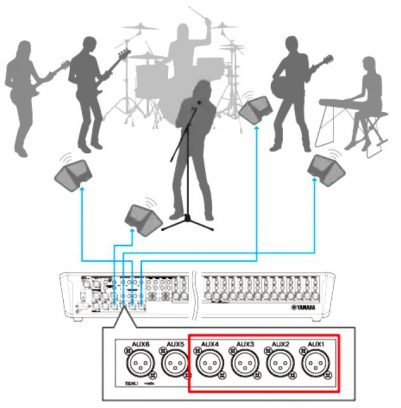
Mixing Stage Monitors
The mixing of sound for stage monitors is an important job of an audio engineer or technician. For a professional group, this is the job of a dedicated engineer, while another person mans the Front Of House (FOH) mixer. For most worship groups, the FOH engineer often also mixes the sound for the stage monitors. The requirements for these two mixes is quite different, so it is important for an engineer to know these differences.
Two primary differences are that the FOH speakers and the acoustic spaces where they operate are quite different from that of the monitors. Thus, a mix that sounds great at FOH may not be so good through the monitors. In order to effectively mix monitors, you need to be able to hear what each band member is hearing. The only way to do this is to go out and stand in the same spot as them, but this has its problems. One way to deal with this in simple situations is to have a monitor speaker the same as the stage monitors at the FOH position. Even if the two speakers are different, the FOH engineer can hear the mix going to the stage. Often, this is done with headphones, but headphones typically have a frequency response quite different than a monitor wedge. Go listen to the stage mix yourself, and listen carefully to requests from the performers.
Stage monitors have their own directionality, depending on their design. Some have rotatable drivers that can be changed when the monitor is used in different positions. The monitor engineer must know the properties of the wedges and the mics being used and help place the wedges appropriately. The monitor system must be equalized to minimize feedback. This is called "ringing out the monitors." Phil Gates has a good video on this, using the display of a Behringer XAir mixer.
The mix sent to the monitors is usually sent Pre-Fader, so that adjustments of the faders used to get a good FOH sound do not affect the monitors, This means that the mix or mixes sent to the monitors must be set up separately. For a band, the various members may want to have their own personal mix, which means that several monitor mixes must be set up. For example, a vocalist may prefer to near mostly keyboards or guitar in their mix so they are on pitch, and the drummer may want to hear only the bass guitar and vice versa , so the two of them are in sync. If some stage performers have trouble hearing their mix, there are small "hot-spot" monitors that can be placed on a mic stand near them. A picture to the right shows a hot-spot monitor with a microphone, where the hypercardioid polar pattern is shown. Note that the monitor is in the nulls of the pickup pattern.
If a vocal group is involved, they may want to hear themselves to help keep their levels similar and be sure they are on pitch with their parts. If the vocals are sent to the stage mix, the level must be such that feedback is minimized, and the mics used must be directional, with their response nulls aimed at the speakers. This may also mean that the vocalists need to keep the mics close to their mouth, which means they should be using foam pop filters, The mixer must be capable of supporting the number of different mixes required on stage and elsewhere.
Because of feedback issues with vocals in the monitors, it is preferable to keep the vocals out of the floor monitors. This means that vocalists must learn to hear their sounds in the FOH sound and trust the FOH engineer to create a good mix. However, typically the room acoustics require that the FOH speakers be set up and aimed so as to minimize their sound on stage. Whatever is the case, vocalists often must get used to hearing the vocals at a low level. It sometimes helps to reverse the phase of the monitor speakers to help minimize feedback. (See Taming the Wild Stage Monitor.)
If in-ear monitors (IEM) are used. the mixing requirements can be different than for floor monitors. For example, some type of ambient signal may need to be sent to IEMs so that vocalists have a feel for their sound in the house. Some vocalists like to use just one earpiece so they can hear the room sound. However, this defeats the purpose of using IEMs to reduce the sound level for those using them. They end up being exposed to the full sound level on stage. It can be helpful to send a true stereo signal to IEMs. Often, band and crew members, will have different models of in-ear monitors that do not all sound the same, and this complicates things further. When the sound on stage is very loud from things such as guitar speakers, an IEM is often the best solution. See the Resources on this page for additional information.
It can be surprizing for amateur performers to hear their own voice through earphones or earbuds. There is less bone conduction, so the sound may seem somewhat thin. They may conclude the sound is bad, Some education may be needed here. On the other hand, to be able to hear their voice clearly can be very helpful in their singing, but typically, they must get used to hearing their voice in a mix.
Another option becoming more common is the ability to send a multi-channel signal to an on-stage mixing system where individual performers can set up their own mix. This can be expensive and requires a mixer that can support this type of equipment. Often these systems are tailored to particular mixers. Wired earbuds can work in some situations, such as a drummer, but wireless IEMS are often preferred, and these can be very expensive.
Balancing all the technical requirements plus the individual preferences of band members can be quite problematic. The engineer must know his "stuff" and be able to deal sensitively with band members. Band members often know little about the technical issues; they just want to hear what they think they need in their monitors. On the other hand, if you do not have any background as a musician or vocalist, you probably do not fully appreciate what the performers must endure.
Sometimes an inexperienced band member says "I want more of me in the mix." While this may be legitimate, it may be that they have not learned how to hear themselves in the mix.

It turns out that when two sounds are designed to fit together, they combine in such a way that different sounds are produced (harmony), and it takes some experience for a musician or vocalist to recognize this and learn to blend properly. The FOH operator must ensure that all performers are heard in a balanced fashion. The vocals must be heard above the band or soundtrack, and the lead vocalist may need to be heard above others in the group.
Sometimes, the band may feel that the mix they hear should be the same as the FOH mix - they want the audience to hear what they hear, not trusting the FOH engineer to get the best FOH mix. Again the need for some education and diplomacy by the engineer. However, it is important to remember that it is all about the performers. As an audio engineer. you are only there to make them sound the best they can. Make them happy!







